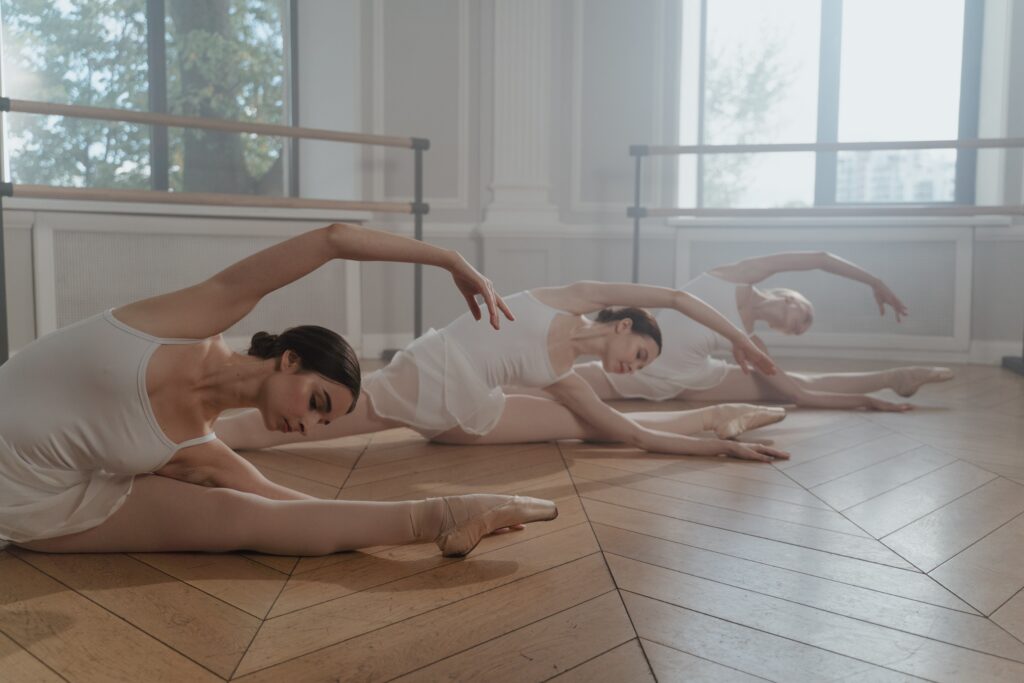Stretching plays an essential role in ballet. It helps young dancers improve their flexibility, move more freely, and reduce the risk of injury. However, stretching must be done correctly to remain safe and effective. When young dancers understand how to stretch properly, they can enjoy dancing more and protect their growing bodies.
Why Safe Stretching Matters
Children’s bodies are still developing, which means their muscles, bones, and joints are more sensitive than those of adults. If they push too hard or stretch the wrong way, they can hurt themselves. Safe stretching helps young dancers:
- Improve flexibility gradually
- Prepare their bodies for ballet class
- Recover after dancing
- Prevent strains and injuries
When done correctly, stretching also improves posture and control, both of which are key in ballet.
Stretching Before and After Class
Stretching at the right time is just as important as the stretches themselves. Before ballet class, children should start with a light warm-up. This gets their blood flowing and warms up the muscles.
Warm-Up Before Stretching
Before any deep stretch, dancers should walk around, jog in place, or do light movements like arm circles or leg swings for five to ten minutes. This helps the muscles prepare for stretching and reduces the risk of injury.
Cool Down After Class
After class, stretching helps muscles relax and recover. Post-class stretches should be calm and held a bit longer. This is the best time to work on improving flexibility.
Safe Stretching Tips for Young Dancers
Here are some clear and simple tips to help make stretching safe and helpful for young ballet dancers.
1. Stretch Slowly and Gently
There’s no need to rush a stretch. Moving slowly into each position helps the muscles ease into place without stress. Sharp or sudden movements can cause harm to the body. Young dancers should hold each stretch for at least 15 to 30 seconds without bouncing or pushing too hard.
2. Never Stretch to the Point of Pain
It’s normal to feel a gentle pull or tightness during a stretch, but it should never hurt. Pain is a sign that the body is being overexerted. Teach children to listen to their bodies and stop if they feel anything sharp or painful.
3. Focus on Breathing
Many children hold their breath when they stretch, especially if it feels difficult. Remind them to breathe in slowly through the nose and out through the mouth. Breathing calmly helps the muscles relax, making the stretch more effective.
4. Stretch Both Sides Evenly
It’s common to have a stronger or more flexible side, but both sides should get equal attention. Ensure children stretch both legs, arms, and sides of their body to maintain balance and avoid placing too much pressure on one area.
5. Use Good Posture During Stretching
Proper alignment is key in ballet, even when stretching. Dancers should keep their backs straight and shoulders relaxed. This not only keeps them safe but also helps build muscle memory for good posture during dance.
6. Don’t Skip the Warm Muscles
Cold muscles are tight and more susceptible to injury. Stretching after warming up allows the muscles to move more easily and prevents pulls or strains.
7. Use Support When Needed
If a dancer can’t reach a stretch yet, that’s okay. They can use props like yoga blocks, towels, or the barre for support. For example, if a dancer struggles to touch their toes, they can bend their knees slightly or use a towel to help reach without forcing the stretch.
8. Make It a Regular Habit
Stretching once in a while won’t lead to lasting flexibility. Encourage children to stretch regularly, even on days they don’t have ballet. Just 10–15 minutes a day can make a big difference over time.
Safe Stretching Ideas for Young Ballet Dancers
Here are a few simple stretches that are suitable for young dancers. These can be done at home or during class with proper guidance.
- Butterfly Stretch: Sit with the soles of the feet together and knees out to the sides. Gently press the knees toward the floor while keeping the back tall.
- Seated Forward Fold: Sit with legs stretched out in front. Reach toward the toes while keeping the spine long. Avoid rounding the back.
- Lunges: Step one foot forward and lower the back knee to stretch the hip flexors. Keep the front knee in line with the ankle.
- Side Stretch: Stand or sit and reach one arm overhead, bending gently to the side. Repeat on both sides.
- Calf Stretch: Stand facing a wall and press the heel of one foot into the ground while bending the front leg. This stretches the back of the lower leg.
Always remind dancers to hold each stretch gently and not to rush through the movement.
Conclusion
Stretching is a big part of becoming a strong and graceful ballet dancer. It helps children stay flexible, avoid injuries, and build healthy habits. But it must be done safely and with care, especially for young dancers whose bodies are still growing.
Kew School of Dance understands the importance of proper technique and safe stretching. Our experienced teachers guide every student with patience and care, making sure each child stretches safely while enjoying their ballet journey.
To learn more about our ballet classes and how we support young dancers, contact us at 03 9123 8458 / 0410 311 008.








